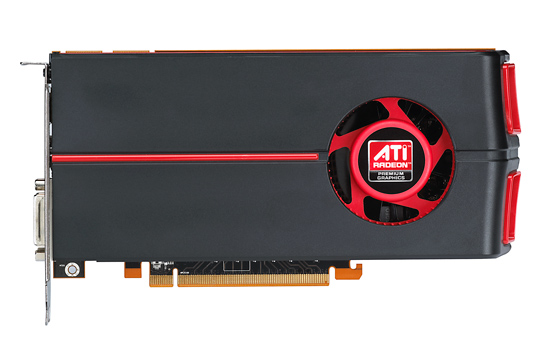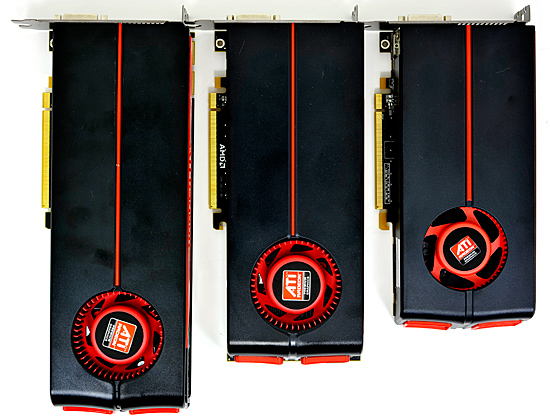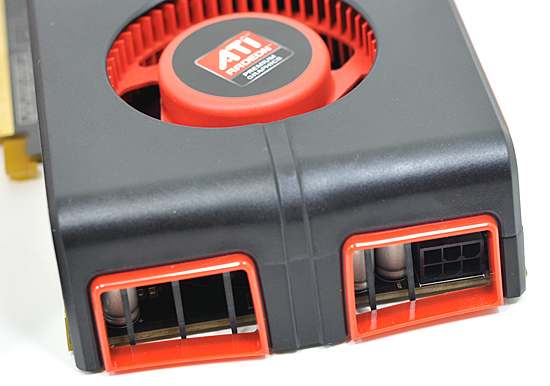AMD’s Radeon HD 5770 & 5750: DirectX 11 for the Mainstream Crowd
by Ryan Smith on October 13, 2009 12:00 AM EST- Posted in
- GPUs
Meet The 5770
We’ll start our look at today’s cards with the 5770. As we mentioned previously the 5770 is the full speed Juniper card, with all 10 SIMDs enabled, and clocked at 850MHz for the core and 1.2Ghz (4.8GHz data rate) GDDR5 for the RAM. As has become the current standard for just about every card over $100 these days, the card is equipped with 1GB of RAM. Attaching this RAM to the GPU is a 128-bit bus, giving the card 76.8GB/sec of memory bandwidth. The use of such fast RAM strikes our interest in particular, since it means vendors are spending just as much to equip a 5770 with RAM as they are a 5870.

For cooling, the 5770 uses the same general plastic shroud as the 5800 series cards, which AMD’s 5700 team told us is called the Phoenix. Here the shroud hangs over the rear of the card by just less than half an inch, making it more like the 5870 than the 5850 where the shroud stopped at the edge of the card. The length of the card is 8.25”, adding the shroud brings it to just shy of 8.75”.

5870, 5850, 5770
Interestingly enough, we’ve been told that the Phoenix shroud isn’t going to be sticking around for long. The first wave of cards launching today and for the near future will be using the shroud, but once AMD’s vendors begin using their own designs, AMD doesn’t expect most of the vendors to stick with the shroud. XFX has specifically been named as a party that will keep using the shroud on products, but anyone else is subject to change. With a TDP of only 108W, the Phoenix shroud is probably overbuilt and certainly more expensive than vendors would like, where mainstream products come with thinner margins. We would expect the vendors that do switch to move to more traditional dual-slot coolers, likely ones that aren’t shrouded at all and would not blow hot air outside of the case.
While we were fine with the shroud on the 5800 series, we do take slight issue with it on the 5770. Because the single 6-pin PCIe power connector on this card is on the rear of the card, the shroud is in the way of the PCIe power connector. This wasn’t an issue on the 5870 since the power connectors were on top, and on the 5850 the shroud stopped at the end of the card. But here the extra shroud makes it much harder to see what you’re doing when it comes to plugging in a PCIe power connector unless you’re looking at the rear of the card, and it makes it a bit harder to remove a PCIe power plug once placed.

AMD made it clear to us that they did consider this in the design of the 5770, and to their credit the shroud never makes inserting/removing a PCIe power plug impossible, but that doesn’t mean we have to like it. We would have liked to see the shroud go the same length as the card, so that it would be just as easy to use as the 5850.
At any rate, along with keeping the 5800 series shroud, the 5770 keeps the port configuration. 1 DisplayPort, 1 HDMI port, and 2 DVI ports make up the card’s output options. This is intentional on the part of AMD, as they want to push Eyefinity on these cards just as much as they do on their high-end products, which means they want to use the same ideal configuration. We wouldn’t be shocked to see this modified at the same time as vendors dropping the shroud though; 1 DVI, 1 HDMI, and 1 DisplayPort with a flexible HDMI->DVI adapter is a likely configuration.

The price of DisplayPort->DVI dongles rears its head once again here, and even more severely. DisplayPort monitors are still rare, so the most likely Eyefinity configuration is going to be 3x DVI, which is going to require a dongle. Those dongles are still going for $100+ right now, which is a significant fraction of the price of the card itself. We talked to AMD about this issue, but it’s something that’s out of their hands for the moment.
AMD is pricing this card at $159. This puts it in competition with the cheapest GTX 260s from NVIDIA, and AMD’s 4870, the latter of which tends to sell for only $10 less for the 1GB version. AMD wouldn’t give us a clear idea on how long they expect the 4870 to last, but it seems clear that they intend to phase out the 4870 with the 5770. This may not be such a great idea, but we’ll get to that after we take a look at performance.
Notably, this leaves a $100 pricing hole in AMD’s 5000-series product lineup, since the next card up is the $259 5850. AMD pointed out to us that this is by no means unprecedented (the 4800 series launch saw a $100 gap between the 4870 and 4850) but we’re not used to seeing such a gap in recent times. This price gap makes a little more sense with AMD’s target demographics: the 5800 series is for 2560x1600 gaming, while the 5770 is targeted for 1920x1200/1080. So as far as they’re concerned, there isn’t a demographic gap to make the price gap a problem.
Anyhow, for the time being, the 4890 will function as a slight bridge on that pricing gap. It will continue to occupy a range around $180-$200.
For today’s launch, availability is expected to be in the “tens of thousands” of units. We suspect that the situation is going to mirror the 5870 launch (tight availability at first) but we’ll see. For this launch period, AMD is also extending the DIRT 2 freebie offer to vendors that want to include it with their 5770 cards. So most if not all cards will come with a voucher for this game to get it in December.










117 Comments
View All Comments
Spoelie - Tuesday, October 13, 2009 - link
The difference is obviously the memory bandwidth. It seems to me that ATi should have gone with a 192bit bus, this change alone would have made the HD57x0 a worthy successor to the HD48x0 range, without any performance caveats, while still being significantly cheaper to manufacture (40nm vs 55nm, 192bit vs 256bit).Skiprudder - Tuesday, October 13, 2009 - link
I'm guessing your right, but I'd like to see Anand (or Ryan) do one of the track-down-the-engineers that this site is famous for, and hear the rational on AMD's part.CarrellK - Wednesday, October 14, 2009 - link
Anand knows where I live...CarrellK
futrtrubl - Tuesday, October 13, 2009 - link
Or even just overclock the memory and see how performance scales. That would provide some evidence for the memory bottleneck theory.plague911 - Tuesday, October 13, 2009 - link
At this price point it looks like the 5770 & 5750 are priced to pad AMD's pockets, not to provide increase performance (not that, that's a bad thing when in a war with Intel). With the smaller process size and smaller chip size and similar performance each new part sold will net AMD a substantialy higher profit. This is why AMD will likely kill off the older gen instead of droping the price point.MadMan007 - Tuesday, October 13, 2009 - link
Yes I think that's where my mild disappointment comes from. Not that they aren't great cards for the launch MSRP, they just aren't great in light of street prices, but unlike HD4800 or even arguably HD5800 AMD doesn't seem interesting in shifting the price/performance curve with these cards. At best matching the current price/performance curve leaves me a bit cold.MonkeyPaw - Tuesday, October 13, 2009 - link
That's been the trend from ATI lately with their mid-grade cards. The 5700 series is meant to offer roughly the same performance of the 4800 series for a cheaper price. The 4600 series last time was meant to match the 3800 series (the 4770 was quite an oddball though). It's not a bad system, really, as it allows ATI to migrate their lineup with some consistency.Lonyo - Tuesday, October 13, 2009 - link
It might be that some of the cost does indeed come from the RAM though.Once GDDR5 chips drop some more, it will be easy for AMD to drop the prices on these cards, but that might (might) be what's limiting pricing options.
Or AMD just want to try and get maximum profit from these cards.
But even so, when GDDR5 prices drop it will be easier to extract profit at lower prices, so GDDR5 pricing will still be at least partly responsible.
geok1ng - Tuesday, October 13, 2009 - link
Reading the charts it gets obvious that it is upgrade time: lets get 4850s, 4870s, and even 4850X2-4870X2 on the next weeks before these cards phase out: they are faster and a LOT cheaper than the 57xx series. As for the high end consumers, just wait for the 5870X2, now that is a card to roll eyes, when and IF it launches.codedivine - Tuesday, October 13, 2009 - link
This is relevant only for compute folks like me, but does 57xx support double precision?